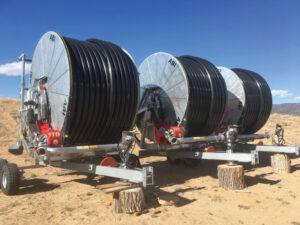By Ron Sering
Editor’s note: This article is a follow-up to one written in our January/February 2013 issue.
The long journey for the area near Nathrop known as Hill Ranch began in 1886, when irrigation rights were first established for use in agriculture and ranching. Exactly a century later, the Hill family sold the rights to Western Water Rights LLC, a water broker. Water brokers are what the name implies: they acquire water rights and sell them as commodities.
The rights, totaling nearly 1,900 acre-feet and fed by six different ditches, were subsequently sold to the fast-growing Pueblo West Metropolitan District (PWMD). Pueblo West remains among the fastest growing communities in the state. Under terms of the agreement, the rights were converted from their former agricultural usage to municipal. Irrigation of the land then ceased, and the land was allowed to dry out.
More than a century of abundant water opened an opportunity for more water-loving vegetation, including aspen and cottonwood trees that in time grew massive. The dry-out spelled the end for them and gave rise to the usual invasive weed suspects, including Canada thistle, common mullein, hoary cress and dalmatian toadflax. In addition, the invasive species began encroaching on neighboring properties.
This drew the attention of the Chaffee County government, which invoked the state’s 1041 regulations, a set of regulations giving local governments a say in land utilization, in particular the buy and dry practice, in which larger municipalities acquire rural water rights and transfer them to municipal use. In a 2006 water court settlement, PWMD agreed at their own expense, to eradicate the invasive weeds and return the land to its original, pre-irrigation condition.
Over a century of traditional flood irrigation practices had changed the ecosystem from drought-resistant high prairie grass to irrigation-induced wetland. In addition to the growing population of cottonwood and aspen trees was a layer of peat moss, formed from the remains of decomposing vegetation. The peat layer has proven problematic as an unsuitable medium for revegetation, and a potential fire hazard as well. A revegetation project launched in the 2010s delivered disappointing results.

“The peat just isn’t a conducive environment for grasses,” said Gerry Knapp, Rocky Ford resident and water consultant. Knapp, and partner Paul Flack, also a water consultant, were brought in to help in 2019.
“Pueblo West hired us as contractors to assess the area, because the results just weren’t what they should’ve been,” Knapp said. “We found significant issues.”
The renewed revegetation project launched in spring of 2019, with several test plantings of a new mixture of grasses. “We’re going to try native grasses, with a combination of cool and warm weather grasses,” Knapp said. “We’re shooting for a grass community as much like the original native grasses as possible.”
Knapp is careful to control expectations. “In some areas, the peat is about a foot thick,” he said, “and may never be able to grow grass.” Area landowners could opt-in to the revegetation plan and receive water for the reseedings. Currently, the water rights remain in use as irrigation.
Weed removal includes large scale mowing operations, with limited use of herbicide for serious noxious weed infestations. Operations will include both the Hill Ranch area proper, and any adjoining land affected by the dry out, predicated on their participation. The target area for reseeding totals 100-150 acres.
In addition to an expanded reseeding operation, plans for this year include installing a sprinkler irrigation system, consisting of large, self-propelled sprinklers fed by reels of four inch tubing. “Each reel will run about a quarter mile of line,” Knapp said. “All water attributable to the rights will be available.” The sprinklers will be deployed from approximately May through September, and be combined with the traditional flood irrigation.


